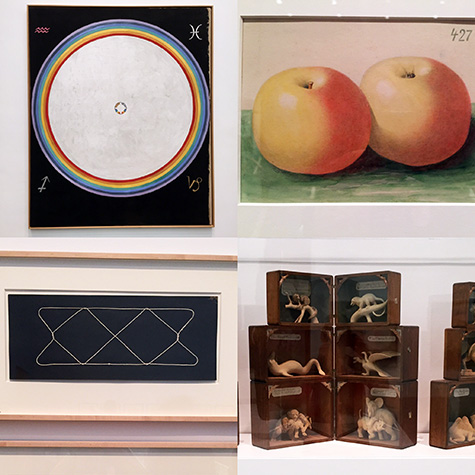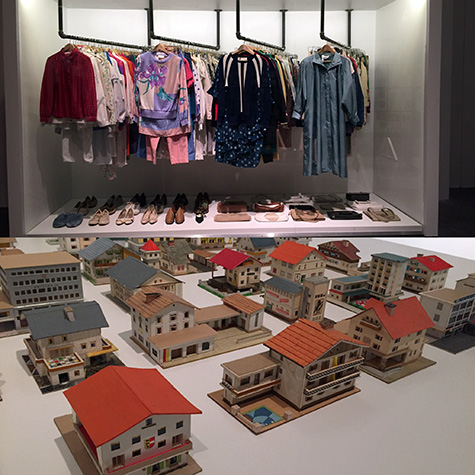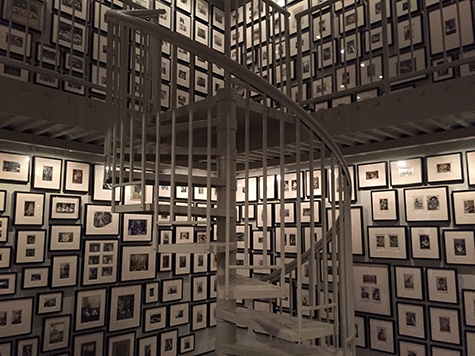“The Keeper” Sparks Bodily Joy
According to the popular and best-selling KonMari religion, we are to believe that decluttering—ridding ourselves of things that do not spark bodily joy—will make us joyous and righteous. “The Keeper,” a new, 4-floor show at New Museum provides opposing viewpoints, much more complex in uncovering the myriad reasons and emotional underpinnings of why we collect and how collections give meaning. Displaying thousands of objects spanning the 20th century, “The Keeper” asks us to examine the dissolving boundaries of art creators, curators, collectors, hoarders and preservers. Each individual can be said to be the keeper of their own personal museum.
 Clockwise from upper left: Works by Hilma af Klint, Korbinian Aigner, Levi Fisher Ames, and Harry Smith.
Clockwise from upper left: Works by Hilma af Klint, Korbinian Aigner, Levi Fisher Ames, and Harry Smith.
For Swedish painter Hilma af Klint, it was her theosophical musings in the form of a collection of colorful, meticulous oils depicting her own cosmology that she hid during her lifetime. For the priest, pomologist and Dachau prisoner, Korbinian Aigner, it was by painting gouache studies of apple and pear specimens that he could understand and record his experiments of growing them. Civil War veteran Levi Fisher Ames created and toured with his cabinets of personal curiosity, featuring phantasmagorical menageries of hand-sized creatures he whittled from basswood.
 Top: Howard Fried’s “The Decomposition of My Mother’s Wardrobe”
Top: Howard Fried’s “The Decomposition of My Mother’s Wardrobe”
Bottom: “The 387 Houses of Peter Fritz”
How does one share a passion of ephemeral discovery? Vermonter Wilson Bentley captured the “tiny miracles of beauty,” snowflake crystals, imaging them with photomicrographs. How do you relive the youthful fun of playing cat’s cradle? Beat artist Harry Smith created collections of string configurations mounting them on simple black grounds. How does one keep a loved one’s memory alive? For Howard Fried, “The Decomposition of My Mother’s Wardrobe” (2014-ongoing,) it is by illuminating the contents of his late mother’s closet, to display, lend and give new life to her by sharing her clothing—not only with museum goers—but with friends who wear and preserve them. For the quilters of Gee’s Bend, the fragments of loved ones’ garments and other remnants coalesce in these iconic commemorative pieces.
What are the roles and responsibilities of the discoverers of others’ collections? Two people preserved 387 models of meticulously built vernacular architecture created by Viennese insurance clerk Peter Fritz that they found in little garbage bags in a thrift shop. Tong Bingxue discovered and preserved 63 annual studio portraits of the distinguished Ye Jinglu, now a photobiography.
 Ydessa Hendeles’ “Partners (The Teddy Bear Project”
Ydessa Hendeles’ “Partners (The Teddy Bear Project”
For those who lost family in the Holocaust or survived it, collections are evidence and memory. The heartbreaking denouement of “The Keeper” is the work of a curator, art historian and an only child of survivors. Ydessa Hendeles’ 2002 “Partners” (The Teddy Bear Project) is a two-story library chamber, installed with Escherian staircases, and encrusted with 3000 framed family photographs of people clutching teddy bears—the ultimate metaphor for something that gives us bodily joy and comfort. Even if you have recently created joy from the negative space you have worked hard to create, you will still experience melancholy, sympathy, gratitude, comfort and humanity when you share others’ collections in “The Keeper.” The show opens today and runs through September 25, 2016.